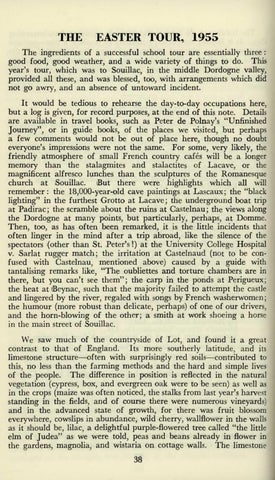THE EASTER TOUR, 1955 The ingredients of a successful school tour are essentially three : good food, good weather, and a wide variety of things to do. This year's tour, which was to Souillac, in the middle Dordogne valley, provided all these, and was blessed, too, with arrangements which did not go awry, and an absence of untoward incident. It would be tedious to rehearse the day-to-day occupations here, but a log is given, for record purposes, at the end of this note. Details are available in travel books, such as Peter de Polnay's "Unfinished Journey", or in guide books, of the places we visited, but perhaps a few comments would not be out of place here, though no doubt everyone's impressions were not the same. For some, very likely, the friendly atmosphere of small French country cafes will be a longer memory than the stalagmites and stalactites of Lacave, or the magnificent alfresco lunches than the sculptures of the Romanesque church at Souillac. But there were highlights which all will remember : the 18,000-year-old cave paintings at Lascaux; the "black lighting" in the furthest Grotto at Lacave; the underground boat trip at Padirac; the scramble about the ruins at .Castelnau; the views along the Dordogne at many points, but particularly, perhaps, at Domme. Then, too, as has often been remarked, it is the little incidents that often linger in the mind after a trip abroad, like the silence of the spectators (other than St. Peter's !) at the University College Hospital v. Sarlat rugger match; the irritation at Castelnaud (not to be confused with Castelnau, mentioned above) caused by a guide with tantalising remarks like, "The oubliettes and torture chambers are in there, but you can't see them"; the carp in the ponds at Perigueux; the heat at Beynac, such that the majority failed to attempt the castle and lingered by the river, regaled with songs by French washerwomen; the humour (more robust than delicate, perhaps) of one of our drivers, and the horn-blowing of the other; a smith at work shoeing a horse in the main street of Souillac. We saw much of the countryside of Lot, and found it a great contrast to that of England. Its more southerly latitude, and its limestone structure—often with surprisingly red soils—contributed to this, no less than the farming methods and the hard and simple lives of the people. The difference in position is reflected in the natural vegetation (cypress, box, and evergreen oak were to be seen) as well as in the crops (maize was often noticed, the stalks from last year's harvest standing in the fields, and of course there were numerous vineyards) and in the advanced state of growth, for there was fruit blossom everywhere, cowslips in abundance, wild cherry, wallflower in the walls as it should be, lilac, a delightful purple-flowered tree called "the little elm of Judea" as we were told, peas and beans already in flower in the gardens, magnolia, and wistaria on cottage walls. The limestone 38
Issuu converts static files into: digital portfolios, online yearbooks, online catalogs, digital photo albums and more. Sign up and create your flipbook.






















